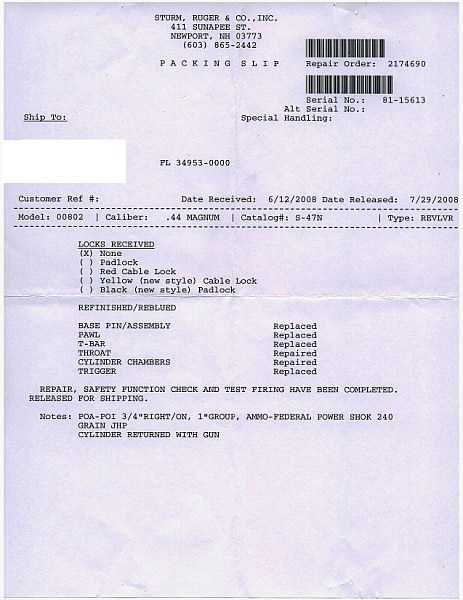
Item E050971 Collector Actual Factory Restored Receipt of this First Year(1974) and Ruger 44 Magnum History of the Super Blackhawk (Now Called Blackhawk Down) |
Handgun hunters, long-range competitors and fans of the single action revolver are attracted to the classic design, rugged durability and smooth functioning of the New Model Super Blackhawk. Designed specifically to exploit the full potential of the powerful .44 Magnum cartridge, its advanced design sets the single action revolver standard for reliable performance for big-game hunters. History In the early 1950s, Westerns were popular in movies and television. Colt had discontinued the iconic Single Action Army prior to World War II, and few single-action revolvers were available to meet market demand for cowboy-style revolvers. In 1953, the new firm of Sturm, Ruger and Company introduced the Ruger Single Six, a scaled-down .22LR rimfire single-action revolver. The Single Six proved to be a popular seller, leading Ruger to develop and market a full-sized revolver similar to the Colt Single Action Army: The Ruger Blackhawk. Ruger introduced the Blackhawk in 1955. Chambered for the .357 Magnum, the Blackhawk was a simple and strong design, and sold well. In 1956, as Smith & Wesson was introducing the new .44 Magnum, Ruger quickly developing a variant of the Blackhawk in the new cartridge. Ruger achieved wide popularity with this firearm in a hotly-anticipated new cartridge, which was both cheaper and more readily available than the Smith & Wesson Model 29 revolver. According to popular legend, Ruger was able to field a .44 Magnum revolver at nearly the same time as Smith & Wesson due to a Ruger employee finding expended .44 Magnum cartridge casings at a scrapyard, and deducing that S&W was about to launch a new cartridge. The 1955-1962 Blackhawks are known today as the Flattop models, because their adjustable rear sights were not protected by "ears" extending up from the frame as later became standard. From 1962 through 1972, Ruger made the "Three Screw" Blackhawk in various calibers, so called by the number of screws visible on the side of the revolver. The Flattop and Three Screw Rugers were modernized compared to the Colt Single Action Army, in that they had adustable sights instead of the Colt's fixed sights, and they used wire coil springs instead of the Colt's flat leaf springs. Bill Ruger chose coil springs due to their greater durability, claiming that it solved one of the primary weaknesses of the Colt design. The early models of the Blackhawk still operated the same way as the Colt, in that the hammer was half-cocked to load and unload, and that the firearm was not safe to carry with all six chambers loaded due to the hammer resting upon the sixth chamber. In 1974, in order to eliminate accidents occurring from the hammer jarring against a round loaded in the sixth chamber, Ruger introduced the New Model Blackhawk. "This Model" The New Model Blackhawk does not require the hammer to be half-cocked for loading and unloading, and employs a transfer bar mechanism which prevents the cartridge under the hammer from being fired without the trigger being pulled. The New Blackhawk is seen as limiting firearms accidents and legal liability. Ruger is now offering a retrofit program, offering free transfer bar conversions to earlier variants of the Blackhawk. |
